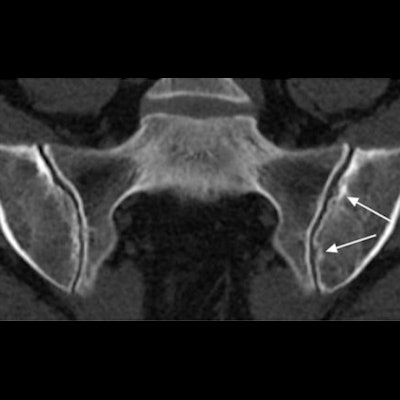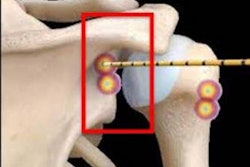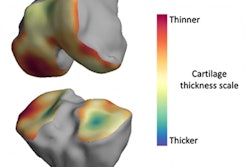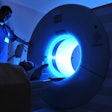
MRI-based synthetic CT images are better than T1-weighted MRI images at identifying structural lesions in patients with suspected sacroiliitis, according to a study published December 22 in Radiology.
The results suggest a way to diagnose patients that doesn't expose them to the radiation of CT but offers the benefit of that modality's ability to better visualize bone than would MRI, wrote a team led by Dr. Lennart Jans, PhD, of Ghent University Hospital in Belgium.
"In our study, all structural lesions could be more reliably depicted with synthetic CT than with T1-weighted MRI," the group wrote.
The researchers noted that different techniques have been previously evaluated for producing CT-like images from MRI scans and providing quantitative data similar to the Hounsfield units derived from CT. The challenge is that no single MRI parameter translates easily into Hounsfield units.
To solve this challenge, the researchers developed a deep learning-based approach that uses multiple qualitative and quantitative tissue-based parameters from MRI that could be used to provide synthetic CT images that are quantitatively accurate.
They tested the technique by using it to evaluate lesions in the sacroiliac joints. MRI is the imaging standard for this application, yet structural lesions can be difficult to identify on T1-weighted MRI scans. CT visualizes these lesions, but putting patients through both MRI and CT exposes them to radiation and complicates department workflows. That's where synthetic CT data could come in handy, the investigators noted.
Jans and colleagues explored the performance of MRI-based synthetic CT for visualizing erosions, sclerosis, and ankylosis of the sacroiliac joints, comparing it with T1-weighted MRI. The study included 30 participants (mean age, 40) who presented at a hospital outpatient rheumatology clinic between February and November 2019.


Images in a 51-year-old woman with erosions. (A) T1-weighted MRI, (B) CT, and (C) synthetic CT scans. Erosions (arrows) are clearly depicted on C but less clear on A. Images and caption courtesy of the RSNA.
All patients underwent MRI and CT of the sacroiliac joints on the same day. Two readers marked the presence of structural lesions on T1-weighted MRI, synthetic CT, and CT in separate sessions for each; CT results were considered the reference standard.
The team found that synthetic CT of the sacroiliac joints had better diagnostic performance for detecting structural lesions in patients with suspected sacroiliitis compared with routine T1-weighted MRI.
| T1-weighted MRI vs. synthetic CT for structural lesions in sacroiliac joints | ||
| Performance measure | T1-weighted MRI | Synthetic CT |
| Erosion | ||
| Accuracy | 86% | 94% |
| Sensitivity | 69% | 78% |
| Specificity | 89% | 96% |
| Sclerosis | ||
| Accuracy | 81% | 97% |
| Sensitivity | 20% | 94% |
| Specificity | 100% | 98% |
| Ankylosis | ||
| Accuracy | 84% | 92% |
| Sensitivity | 70% | 93% |
| Specificity | 88% | 91% |
"The probability of having high diagnostic confidence with synthetic CT was higher than with T1-weighted MRI in the detection of erosion and ankylosis," the group wrote. "We found that synthetic CT significantly improved specificity in the detection of erosion without loss of sensitivity in comparison with T1-weighted MRI. This is useful because concerns have been raised about the specificity of MRI of [sacroiliac] joints in the diagnosis of spondyloarthritis."
Since sclerosis and ankylosis are signs of bone repair after inflammation, using synthetic CT to identify these conditions could improve patient care when it comes to follow-up and therapy guidance, according to Jans and colleagues. And the study findings could translate into better departmental efficiency as well, wrote Dr. Jan Fritz of NYU Grossman School of Medicine in New York City in an accompanying editorial.
"The synthetic CT technique promises efficient clinical workflow integration and compatibility with multiple vendor platforms," he wrote.



















